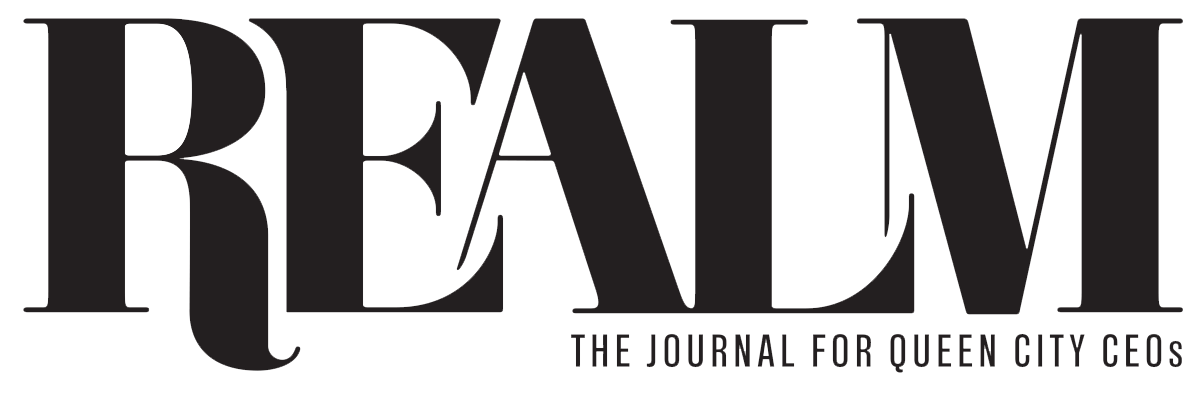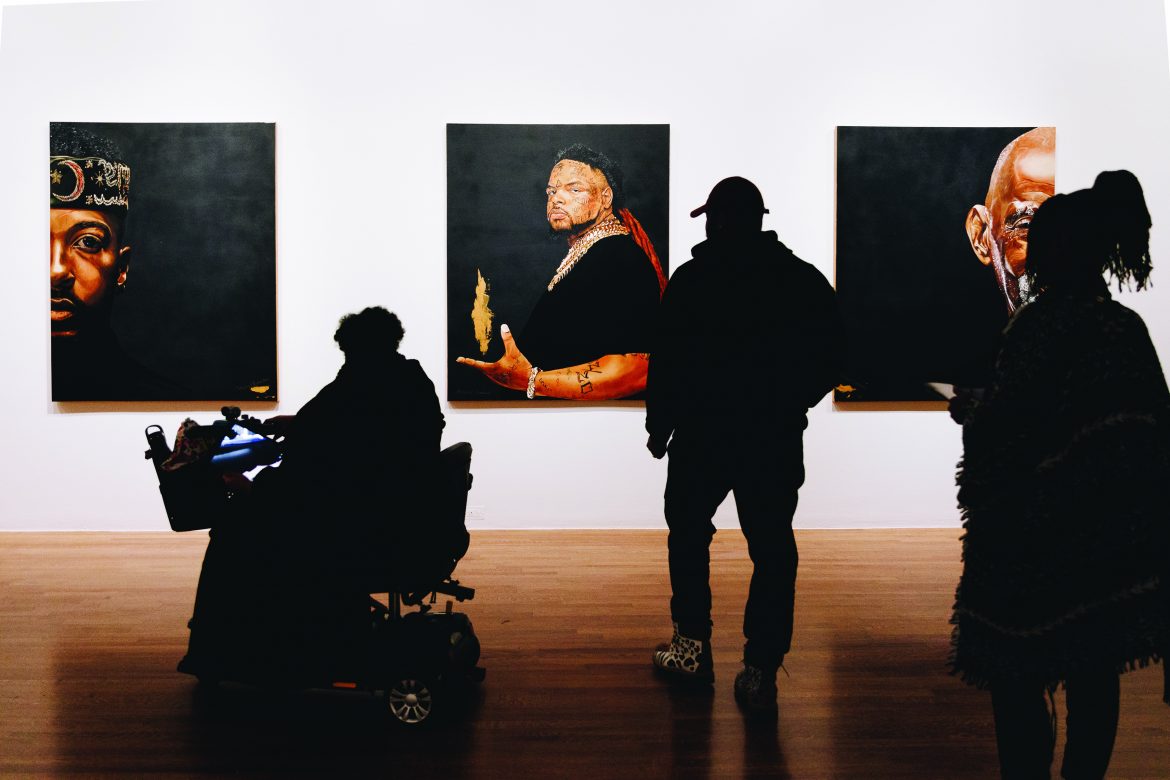The colors are vivid. There’s a distinctly modern look with a more flattened and abstract view of faces and landscape. One can see hope, pride, or despair in the same set of eyes. The sculpture can be haunting or introspective, depending largely on the preconceived notions you didn’t even know you had.
That’s art. In this case, it’s African Modernism in America, coming to the Taft Museum of Art in February. It’s a snapshot in an album quickly expanding to explore and celebrate the diverse craftsperson who holds the chisel and applies the brush strokes.
“It’s a generational shift,” says Rebekah Beaulieu, the Taft’s president and chief executive officer. “Museums recognize that art should reflect and inspire your community, favoring a more dialogic view than just me sitting on a velvet throne simply dictating what we should be looking at.”
Rembrandts, Gainsboroughs, and deGoyas grace the walls of the downtown museum. They’ve been there for decades and will remain for many more. But the traveling African Modernism exhibit will expose Cincinnati to works from such artists as Ben Enwonwu of Nigeria, Peter Clarke of South Africa, and Skunder Boghossian of Ethiopia, mid-20th-Century masters who the exhibition will link to the cultural and political changes that were happening here in the U.S. The show will be on display through May 19.
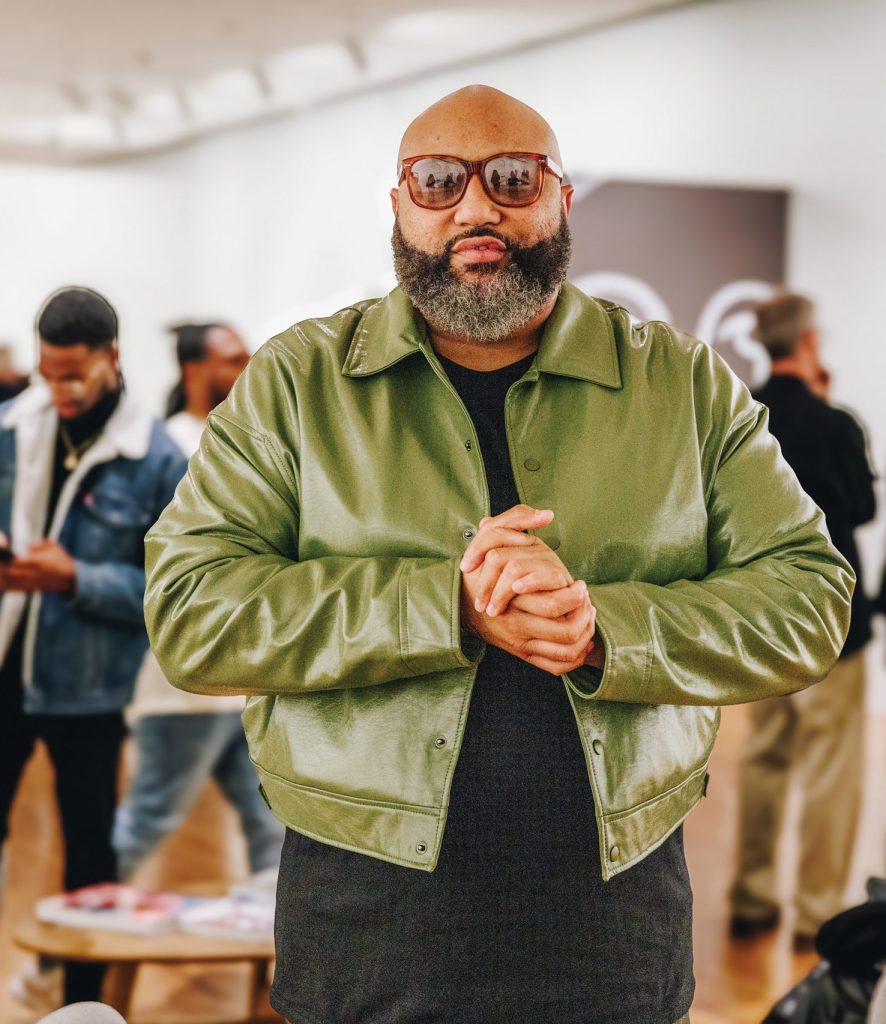
The African masters will share their environs with Robert Duncanson landscapes that frame the original front entrance to the 200-year-old home of several prominent city leaders from our past. “We are a global society now, and Cincinnati reflects that,” says Beaulieu, noting specifically Procter & Gamble’s international reach and diverse employee base. ‘’But, for many of us growing up, we were taught art through the white Euro-centric lens. We started with the classics, went on to the Renaissance, then the Enlightenment. But there was a whole other world out there that we really didn’t know. It’s exciting to stretch our wings and explore it.”
The Taft Museum isn’t the only local arts organization exposing its patrons to work from elsewhere. The third installment of Paloozanoire’s Black & Brown Faces at the Cincinnati Art Museum, Verified: An Ode to the Cultural Influences That Inspire Nations, focuses on multimedia art from 15 Midwestern artists of color who celebrate the global impact of Black and Brown culture on everything from fashion and food to entertainment and science. The show is on display through January 21, running alongside Clearly Indigenous: Native Visions Reimagined in Glass, featuring 120 glass pieces by 33 Native American artists who use their art to tell traditional stories and promote social justice.
Two exhibitions ran side-by-side at the Contemporary Arts Center in the fall. An Ecology of Here used original art, film, and photographs to highlight the work of BIPOC farmers, artists, and gardeners in providing nourishment to their communities. The challenges of inner-city youth were explored in a series of prints provided by Philadelphia’s Rush Arts Foundation.
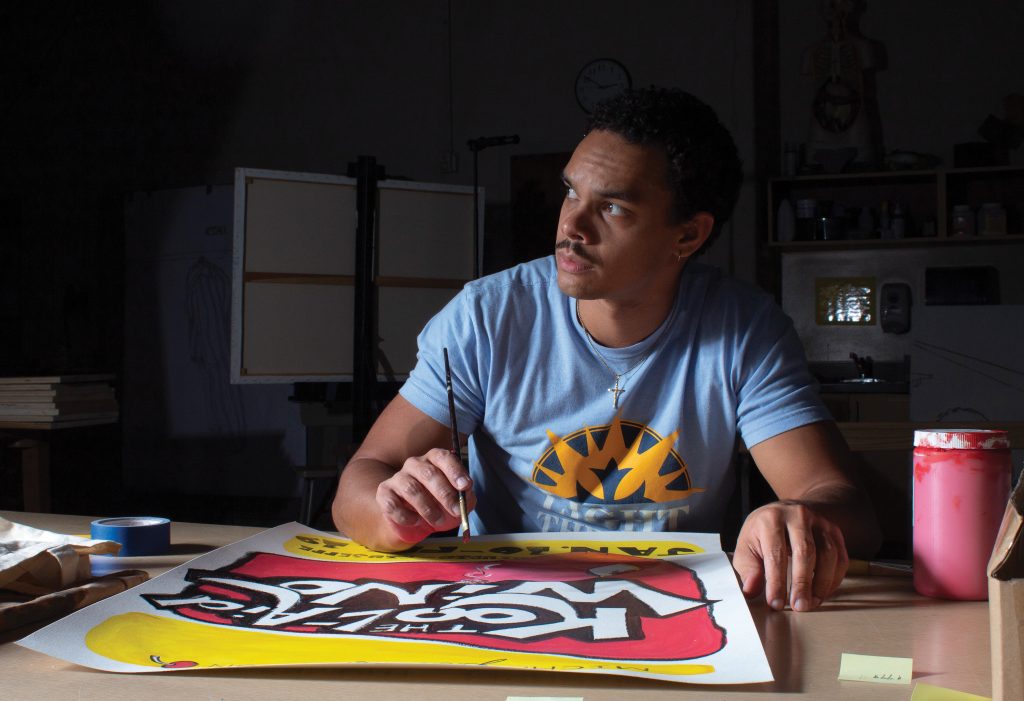
Michael Thompson sits hunched over a painstaking calligraphy he’s preparing for his upcoming art exhibition, which will run for a month starting in mid-January. He’s the first artist-in-residence at Mount St. Joseph University, and he’s an up-and-comer. He’s 24 years old and says he really didn’t begin to seriously paint until he was in college at Thomas More University.
Thompson is tall with an athletic build and an electric smile. He credits his college advisor for altering his life’s direction. Take an elective, his mentor said, that gives you enjoyment. The arts had always intrigued him, and he thought back to an art class he took as a child in a studio above a laundromat in Richmond, Kentucky, and remembered how he loved it. He already wrote and gave poetry readings, so the creativity was raw but ready.
Thompson took the elective class, and the spark was lit. Soon after, he dropped his international business major and triple majored in English, Spanish, and Fine Arts. His work was noticed quickly thanks to his initial job with ArtWorks. In short order, he earned residencies at the Cincinnati Art Museum, Cincinnati Shakespeare Company, Cincinnati Chamber Orchestra, and the Contemporary Arts Center. He’s secured grants and special commissions. He’s a good example of an arts community supporting a home-grown talent thanks, in large part to the business community and local foundations that provide funding.
“We support the arts because it represents diversity and fosters an inclusive environment of different experiences, personalities, and history,” says Rhonda Whitaker Hurtt, Duke Energy’s vice president of community relations and economic development. “It creates a quality of life and a vibrant community, which is why people want to move here. We’ve seen in our economic development efforts that it absolutely matters.”
Hurtt, who has worked local economic development issues for nearly 30 years, says Cincinnati’s nationally-recognized commitment to the arts tells a story of a community that invites expression and creativity—attributes that attract and excite young professionals. The emphasis on Black and Brown artists and the diverse audience they attract, she maintains, recognizes and celebrates our community’s changing demographics, which in turn helps companies recruit talented people of color to their rosters.
Hurtt also ties Duke’s commitment to diversity in the arts to the company’s efforts to diversify its own employee base, which also reflects the growing diversity of its customer base. That commitment, she says, goes back to its days as Cinergy, when the company sponsored an art collection that won an award from Forbes.
Perhaps the biggest paint brush Cincinnati has in its arsenal is ArtsWave, one of the nation’s largest and most effective nonprofit supporters of the arts. Over the past 96 years, the consortium has partnered with the community to help fund museums exhibits, stage performances, dance companies, music from opera to hip hop, individual artists, and dozens of special projects such as BLINK that have enriched the region’s cultural life.
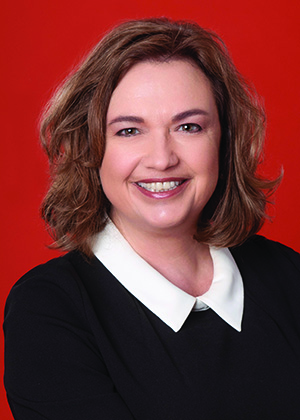
Its annual campaign is well-organized and has for decades enjoyed the support of the region’s major corporations, foundations, and individual donors. Last year, the campaign raised $11.8 million, exceeding its goal and reaching a return to pre-pandemic contribution levels.
ArtsWave augments its budget by leveraging the community’s contributions, regularly securing competitive state and federal grants. Part of that funding has gone into the Black & Brown Faces and African Modernism exhibitions, two of the five offerings that make up its 2023-24 Flow season. Now in its fourth year, Flow is ArtsWave’s signature celebration of African American visual, music, and dance. The Flow Pass entitles purchasers to events and social opportunities that bring diverse audiences together to experience both the talent and the social messaging inherent in the works of the artists.
Flow was launched just before the pandemic hit but didn’t find its legs until the 2021 season, when ArtsWave secured corporate sponsorship for a series of free cultural events. “There was a gap on our stages and in our galleries,” says Janice Liebenberg, ArtsWave’s vice president of equitable arts advancement. Flow, she says, gives Black and Brown artists a chance to demonstrate their talent, but perhaps more importantly it speaks to the “culturally curious” arts patrons of all races and experiences.
From the outset of Flow, says Liebenberg, she saw white patrons from the region’s C-suites mingling with young people who “maybe never felt comfortable in one of our legacy theaters” and people of color who had rarely, if ever, attended an arts event. ‘’It started out as a free season pass, but now we sell them and people are buying them,” she says, laughing.
Flow, says ArtsWave CEO Alecia Kintner, has demonstrated that art can be cross-cultural. “Will white people go to a Black play or art exhibit?’’ she asks rhetorically. “The answer, so far, is yes. We’ve been intentional, too, in creating new connections through the social aspect of our events as well as jointly appreciating the talent.”
Kintner believes ArtsWave’s mission is to build audiences and opportunities for artists of color to shine. The organization’s DEI commitment pulls no punches, beginning with the first sentence: “We acknowledge the deep-rooted systemic racism that permeates our society.” It carries that commitment to right a wrong into its funding decisions and its annual campaign, which this year will be led by the husband/wife team of P&G CEO Jon Moeller and Lisa Sauer.
You’ll continue to see the impact on the walls of our art galleries and on the theater stages. Kintner talks passionately about art as a catalyst for building empathy and understanding, bringing people together, and making all feel welcome. That’s important, she says, as major companies such as P&G, Kroger, Fifth Third, and GE work to attract a diverse workforce that reflects their customers’ interests. She points out with pride that Cincinnati, since 2020, has ranked in the top 20 (No. 11 this year) by a major index for arts vibrancy among U.S. cities. Kintner draws a straight line between Cincinnati’s commitment to diversity in the arts and its future potential as a city on the rise. The move toward more diversity and inclusion, she says, is evolutionary—not revolutionary. “The good news is that Cincinnati arts organizations have been doing this for a while,” she says. “This isn’t an ‘ah ha moment’ but a shared journey.”
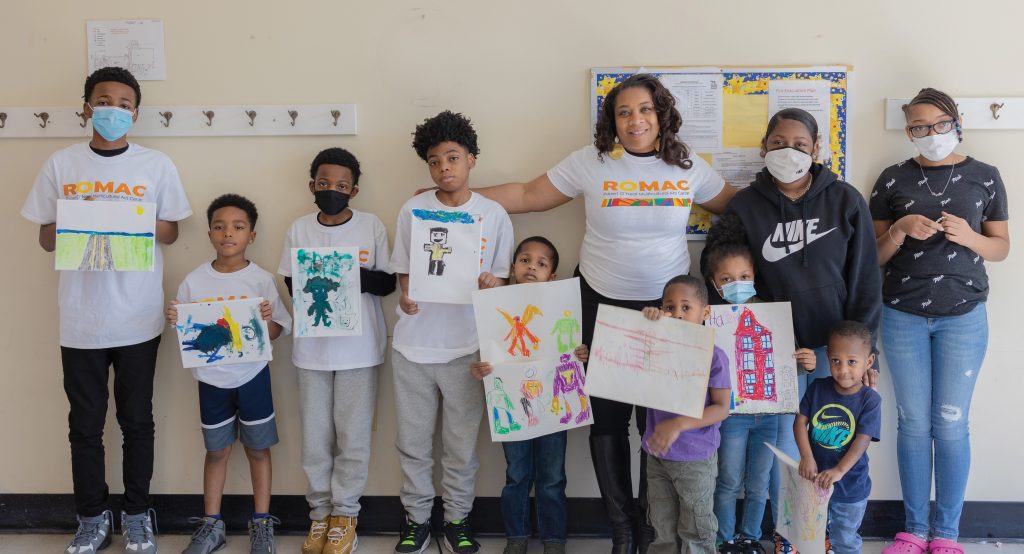
Perhaps Cincinnati’s arts evolution started in 1840 with the arrival of 19-year-old Robert Duncanson to what is now Mt. Healthy. By then, the booming region was already known for its nurturing of the arts as well as its better opportunities for advancement, relatively speaking, for Black citizens.
It was the city’s reputation as the “Athens of the West” that convinced Duncanson that his chance to be an artist lay here. The self-taught artist focused many of his works on African American life along the Ohio River, and his stunning murals adorn the entrance walls of the Taft Museum of Art. The museum also features a Duncanson Artist-in-Residence program that’s highly competitive and draws applicants from all over the country.
Fast forward more than 100 years to the 1960s, when the civil rights movement captured American headlines and riots broke out in dozens of cities, including Cincinnati. From the ashes of those disturbances came the anti-poverty Model Cities program, which in Cincinnati led to the creation of the Arts Consortium, based in the West End and led by artist and political activist Robert O’Neal.
“Arts is almost always activism,” says Toilynn O’Neal Turner, his daughter. “It’s a ‘see me, hear me’ moment from the artist when you look at a piece of art. It’s especially true when it’s Black art, which has always talked about our story.”
Turner, one of the city’s leading advocates for art education, is president of the Robert O’Neal Multicultural Arts Center (ROMAC), which she hopes—with the community’s financial support—will refurbish and activate the old Regal Theater in the West End to house a Black cultural center. “I grew up around both the arts and activism,” she says. “I could be down at City Hall at a protest one day and in the trenches painting a mural the next.”
Turner stands at the intersection of arts and education, consulting for several art museums locally and around the country and, for 22 years, leading St. Ursula Academy’s diversity efforts. She arranges Fountain Square entertainment nights for Visit Cincy. As executive director of the Queen City Foundation, she’s a fierce advocate for rebuilding hope in the West End one student at a time. And she founded and teaches visual arts to teenagers at the West End’s Lincoln Recreation Center.
When I meet Turner at the Rusk Kitchen & Bar in Walnut Hills, she’s dealing with a crisis: Two of her students were among the six people shot in a drive-by the night before on Jones Street in the West End. She’s coping with the pain and the frustration of a community that, she says, needs hope.
Art, she believes, can help. Turner speaks about art not just as a celebration of culture and beauty but as a system. “Art provides a release and changes people,” she says, “but the system of providing access and building capacity for an audience in a community? That’s as important.”
She envisions ROMAC and the 109-year-old Regal Theater building as the focal point for starting a new arts system in the local Black community, built in the mold of her late father’s Arts Consortium. The project earned a $1 million capital grant from the state of Ohio last year, but it requires matching funds and then some. A capital campaign, helped by the experts at Ignite Philanthropy, is underway with a goal of raising $2 million by April.
“We’re really starting from scratch because the Arts Consortium has been gone since 1972 and this building (the Regal) has been vacant for more than 30 years,” says Turner. “But when I go in there, I see it from my childhood lens, where my spot was. It’s got so many possibilities. But I need a friend.”
Turner has a friend in ArtsWave, which contributed $15,000 for ROMAC programming this year—a part of its $100,000 grant package annually awarded since 2015 to promote Black-led arts and culture. But Kintner, Beaulieu, and Turner agree that the corporate and philanthropic community needs to think about expanding its commitment to the arts by supporting what Turner calls “the mom-and-pop art shops.”
It’s the smaller neighborhood arts organizations with the thinner budgets that can directly impact the communities in need, she says. Mom-and-pop groups succeed via word of mouth, friend-to-friend connections, and participating organizations such as local churches and ArtsWave itself.
“More than 300 people came to our Sanaa Festival this year (Sanaa is ‘art’ in Swahili) from all over the city,” says Turner. “We had no billboards, no marketing, nothing. We do a lot with so little. Imagine what we could do with just a few more resources.”
On the canvas at the entrance to Michael Thompson’s Mt. Washington studio, your eyes are drawn to a single tear beginning its steady roll down the right side of a man’s brown nose. Another rivulet has formed from the opposite corner, rolling down the side of his face. It seems like the tears your eyes expel when suddenly introduced to a blast of cold air. You see just his eyes and bushy eyebrows. Are these tears of joy? Grief? Despair? Or is he just cold?
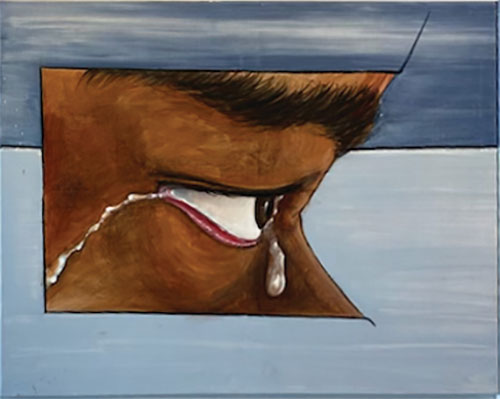
Thompson chuckles at my question, and the answer is the answer any artist might give: It depends on your perspective. What you see is what it is to you.
“The Tear” will be part of Thompson’s art exhibition, entitled The Kool-Aid Wino, from mid-January to mid-February at Mount St. Joseph University. This multimedia collection is his first gallery show as a professional. It won’t be his last.
His work is not political, says Thompson. Art is allowed to be merely aesthetic, offering beauty, joy, and mystery to the viewer. It’s a story told on canvas. If “The Tear,” to you, tells the joyful story of an enslaved man gaining his freedom, that’s a political message you as a viewer built.
Thompson keeps his thoughts about “The Tear” to himself, saying only that he rejects the Black artist archetype of “creating a certain kind of art we’re supposed to create.”
I give “The Tear” another long look, and I’m still not sure. “That’s good,” he says, laughing. “It means I’ve done my job.”
